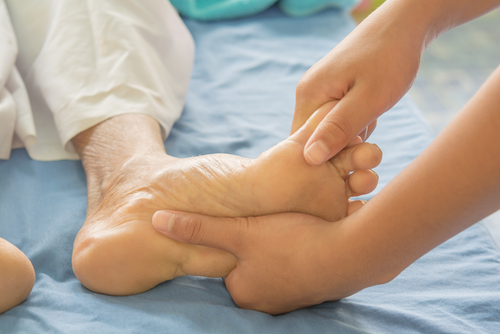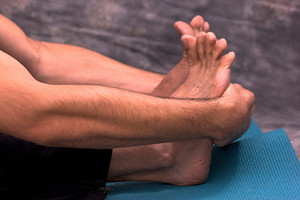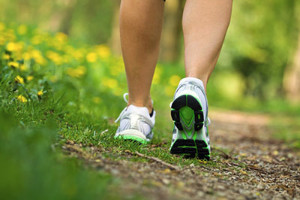Connect With Us
Blog
Items filtered by date: November 2022
The Feet And Body May Benefit From Foot Massages

There are many benefits of getting regular foot massages. This is a type of foot therapy that can enhance the overall feeling of well-being and can bring a relaxed sensation to the feet. There are specific pressure points in the feet that are linked to different organs in the body, and it may help to heal existing medical conditions. Many foot massages are done at home, and this begins by rubbing a lotion into the feet. There is an easy method to perform self-foot massages, which is done by sitting in a chair and resting one foot over the opposite thigh. Pressing the knuckles into the foot can provide a deeper massage, and pulling the toes back and forth can help to release existing tension. There are massage devices that are useful in providing an effective massage. These can consist of foot rollers and electric tools that can stimulate the blood. If you would like additional information about the benefits of foot massages and how to perform them, please consult with a podiatrist.
Foot therapy is often necessary for those recovering from either foot deformities or foot injuries. If you have concerns regarding therapy, consult with one of our podiatrists from Bergen Foot & Ankle. Our doctors can provide the care you need to keep you pain-free and on your feet.
Most Common Injuries
People who are active or athletes are prone to a variety of injuries. Therefore, it is often important to take part in physical therapy in order to quickly get back on the right track.
What to Do When Injured
Physical Therapy – This specialized treatment will focus on the affected area, speeding up recovery and the overall healing process. It is a proven method that has helped millions of people return from any injury.
During physical therapy you will undergo regimented training to get back into full form. Training is often very difficult, especially at first when the foot feels weak. Physical therapy often involves:
Basic stretching and twisting exercises – getting the feet’s mobility and flexibility up.
Massaging – the therapist will massage the injured area in order to activate the muscles and relax them.
Strengthening Exercises – this allows the muscles in the affected area to regain their full strength, a vital step towards full recovery.
If you have any questions please feel free to contact our offices located in Fort Lee, NJ and Flushing, NY . We offer the newest diagnostic tools and technology to treat your foot and ankle needs.
Effective Stretches That May Help Flat Feet

The pain that can accompany the foot condition known as flat feet may or may not affect specific people. It is described as an arch that is absent in each foot and provides shock absorption to the body. The majority of babies are born with flat feet, and the arch generally develops during the teenage years. Consequently, the arch may not develop in some people, and they can experience discomfort with flat feet as they get older. Performing specific stretches may help to strengthen the entire foot, which may help to diminish the discomfort of having flat feet. These can consist of simple stretches that are called the towel scrunch, stair heel raises, and toe extensions. Many patients enjoy practicing the towel stretch, which is done while sitting on the floor, and wrapping a towel around the feet as the toes are pointed up. Additionally, rolling the foot on a tennis ball can invoke feelings of well-being as the feet relax. If you would like additional information about effective stretches to practice with flat feet, please ask a podiatrist who can provide you with useful information.
Flatfoot is a condition many people suffer from. If you have flat feet, contact one of our podiatrists from Bergen Foot & Ankle. Our doctors will treat your foot and ankle needs.
What Are Flat Feet?
Flatfoot is a condition in which the arch of the foot is depressed and the sole of the foot is almost completely in contact with the ground. About 20-30% of the population generally has flat feet because their arches never formed during growth.
Conditions & Problems:
Having flat feet makes it difficult to run or walk because of the stress placed on the ankles.
Alignment – The general alignment of your legs can be disrupted, because the ankles move inward which can cause major discomfort.
Knees – If you have complications with your knees, flat feet can be a contributor to arthritis in that area.
Symptoms
- Pain around the heel or arch area
- Trouble standing on the tip toe
- Swelling around the inside of the ankle
- Flat look to one or both feet
- Having your shoes feel uneven when worn
Treatment
If you are experiencing pain and stress on the foot you may weaken the posterior tibial tendon, which runs around the inside of the ankle.
If you have any questions please feel free to contact our offices located in Fort Lee, NJ and Flushing, NY . We offer the newest diagnostic and treatment technologies for all your foot and ankle needs.
Where Is the Tarsal Tunnel?

The feet endure hundreds of times the body weight of an individual, occurring several times per day. The ankle is responsible for weight bearing, in addition to absorbing the shock, the body endures while walking and running. One of the components of the ankle is called the tarsal tunnel, and the tibial nerve is located inside this tunnel. The foot condition that is known as tarsal tunnel syndrome occurs when the tibial nerve becomes inflamed and compressed, and can cause difficulty in walking. This condition may be prone to people who have flat feet, as a result of abnormal foot structure. Additionally, a tumor or cyst that has developed in this part of the foot may place pressure on the nerve, possibly causing tarsal tunnel syndrome to develop. Common symptoms patients may experience may consist of a burning sensation along the inside of the ankle, and can radiate to the entire foot. Relief may be found when the affected foot is elevated, and walking can temporarily subside. Effective prevention methods may include performing specific stretches that can strengthen the ankle, in addition to warming up and cooling down before and after running. Tarsal tunnel syndrome is treated by a podiatrist, and it is suggested that you confer with this type of doctor who can offer you the correct treatment options.
Tarsal tunnel syndrome can be very uncomfortable to live with. If you are experiencing tarsal tunnel syndrome, contact one of our podiatrists of Bergen Foot & Ankle. Our doctors can provide the care you need to keep you pain-free and on your feet.
Tarsal Tunnel Syndrome
Tarsal tunnel syndrome, which can also be called tibial nerve dysfunction, is an uncommon condition of misfiring peripheral nerves in the foot. The tibial nerve is the peripheral nerve in the leg responsible for sensation and movement of the foot and calf muscles. In tarsal tunnel syndrome, the tibial nerve is damaged, causing problems with movement and feeling in the foot of the affected leg.
Common Cause of Tarsal Tunnel Syndrome
- Involves pressure or an injury, direct pressure on the tibial nerve for an extended period of time, sometimes caused by other body structures close by or near the knee.
- Diseases that damage nerves, including diabetes, may cause tarsal tunnel syndrome.
- At times, tarsal tunnel syndrome can appear without an obvious cause in some cases.
The Effects of Tarsal Tunnel Syndrome
- Different sensations, an afflicted person may experience pain, tingling, burning or other unusual sensations in the foot of the affected leg.
- The foot muscles, toes and ankle become weaker, and curling your toes or flexing your foot can become difficult.
- If condition worsens, infections and ulcers may develop on the foot that is experiencing the syndrome.
A physical exam of the leg can help identify the presence of tarsal tunnel syndrome. Medical tests, such as a nerve biopsy, are also used to diagnose the condition. Patients may receive physical therapy and prescriptive medication. In extreme cases, some may require surgery.
If you have any questions please feel free to contact our offices located in Fort Lee, NJ and Flushing, NY . We offer the newest diagnostic and treatment technologies for all your foot and ankle needs.
See Your Foot Specialist Regularly If You Work On Your Feet
Toe Stretches Are Effective for Several Reasons

An important benefit of frequently stretching the toes is to improve flexibility and range of motion. Strength is generally also improved, and this may contribute to reducing the risk of getting a bunion or plantar fasciitis. Many people enjoy practicing toe lifts. This is done by lifting the toes to the same height while standing, followed by holding this position for several seconds, and then repeating. An effective foot stretch is called the toe lift and spread, and is done while sitting with the feet on the floor. This is a similar stretch as the toe lift, and may be performed by using a resistance band around the toes, which can make it more challenging. Additionally, the big toe can be pulled by wrapping a towel around it while pulling the toe close to you. This can help to improve mobility in this toe, and the entire foot may benefit from it. If you would like additional information about the importance of stretching the toes, and how to accomplish this, it is suggested that you consult with a podiatrist who can guide you in the right direction.
Stretching the feet is a great way to prevent injuries. If you have any concerns with your feet consult with one of our podiatrists from Bergen Foot & Ankle. Our doctors will assess your condition and provide you with quality foot and ankle treatment.
Stretching the Feet
Being the backbone of the body, the feet carry your entire weight and can easily become overexerted, causing cramps and pain. As with any body part, stretching your feet can serve many benefits. From increasing flexibility to even providing some pain relief, be sure to give your feet a stretch from time to time. This is especially important for athletes or anyone performing aerobic exercises, but anyone experiencing foot pain or is on their feet constantly should also engage in this practice.
Great ways to stretch your feet:
- Crossing one leg over the others and carefully pull your toes back. Do 10-20 repetitions and repeat the process for each foot
- Face a wall with your arms out and hands flat against the wall. Step back with one foot and keep it flat on the floor while moving the other leg forward. Lean towards the wall until you feel a stretch. Hold for 30 seconds and perform 10 repetitions for each foot
- Be sure not to overextend or push your limbs too hard or you could risk pulling or straining your muscle
Individuals who tend to their feet by regular stretching every day should be able to minimize foot pain and prevent new problems from arising.
If you have any questions, please feel free to contact our offices located in Fort Lee, NJ and Flushing, NY . We offer the newest diagnostic and treatment technologies for all your foot care needs.
Children, Walking and Running Shoes

Research has indicated that it is beneficial for children who participate in high-impact activities to wear sneakers that are supportive and refrain from wearing walking shoes. Running shoes can accommodate three times the body weight of the child, while walking shoes are capable of handling one and a half times their body weight. There is more cushioning and support surrounding the heel in running shoes, and there is generally less protection surrounding the ball of the foot. They are made of mesh materials, which may be helpful in keeping the feet cool while running or exercising. In comparison, walking shoes are designed to be more flexible, in addition to having better arch support. The weight of the body is distributed more evenly while walking, and it is beneficial to wear the appropriate shoes. If you would like additional information about the differences between walking and running shoes, please consult a podiatrist who can answer any questions you may have.
For more information about walking shoes versus running shoes, consult with one of our podiatrists from Bergen Foot & Ankle. Our doctors can measure your feet to determine what your needs are and help you find an appropriate pair of footwear.
Foot Health: The Differences between Walking & Running Shoes
There are great ways to stay in shape: running and walking are two great exercises to a healthy lifestyle. It is important to know that running shoes and walking shoes are not interchangeable. There is a key difference on how the feet hit the ground when someone is running or walking. This is why one should be aware that a shoe is designed differently for each activity.
You may be asking yourself what the real differences are between walking and running shoes and the answers may shock you.
Differences
Walking doesn’t involve as much stress or impact on the feet as running does. However, this doesn’t mean that you should be any less prepared. When you’re walking, you land on your heels and have your foot roll forward. This rolling motion requires additional support to the feet.
Flexibility – Walking shoes are designed to have soft, flexible soles. This allows the walker to push off easily with each step.
If you have any questions, please feel free to contact our offices located in Fort Lee, NJ and Flushing, NY . We offer the newest diagnostic and treatment technologies for all your foot care needs.

